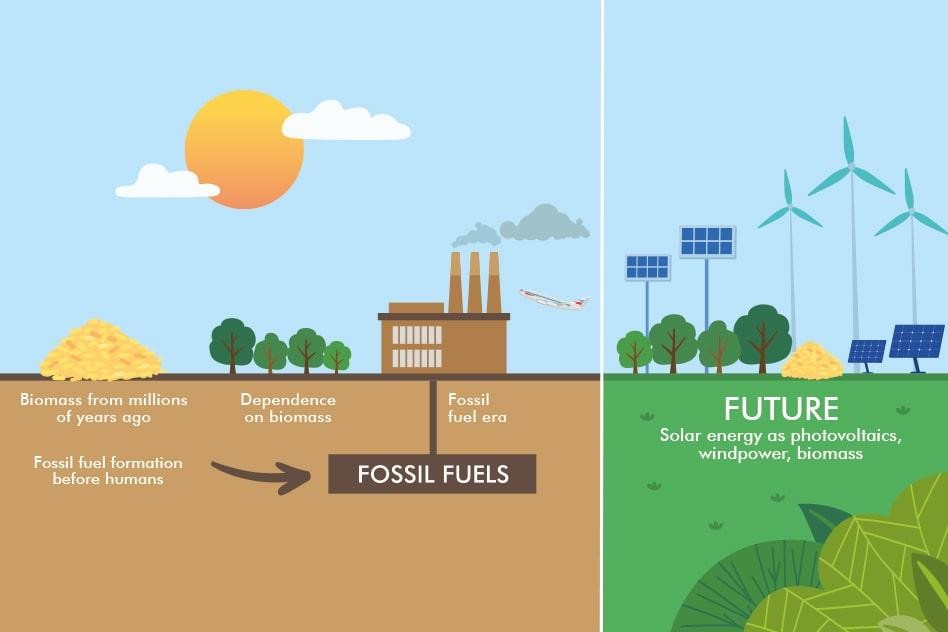Energy in North Carolina
While North Carolina’s renewable energy leaders tend to be larger cities and communities in the Research Triangle region, there are many examples of rural areas and smaller cities benefiting from solar and other forms of clean energy investment.

Driven by the private market and public policy, renewable energy is the most rapidly growing segment of the U.S. energy mix. Between 2011 and 2020, solar power grew 23-fold and wind power nearly three-fold as they became cost-competitive with other sources (Nick et al. 2021). Renewables are projected to continue to displace fossil fuels in the electric power sector due to declining costs, technological improvements (e.g., battery storage), and rising incentives. Electrification of the vehicular fleet will reinforce the shift away from fossil fuels. Energy-related carbon dioxide (CO2) emissions are expected to fall 25%-38% below 2005 levels by 2030, depending on case assumptions ((U.S. EIA 2030). The nation’s goal under the Paris Agreement is to reduce CO2 emissions from all sources by 50-52% of 2005 levels by 2030.
The Challenge
Dramatically reduced fossil fuel use, electrification, and a shift to renewable energy, among other actions, are needed to limit global warming to 1.5o C (2.7o F) below pre-industrial levels, the Paris Agreement target to avoid the worst impacts of climate change. Achieving this target requires the annual deployment of 1000 GW of renewable power and net zero emissions worldwide by 2050 (IREA 2023). The clean energy transition will provide a host of ancillary benefits, such as increased security, reduced pollution, lower energy costs, and green business and job opportunities.

Potential Responses
Short-Term
- Work with Duke Power, electric cooperatives, and other partners (e.g., major institutional and business uses) to identify actions to meet state CO2 reduction targets
- Take advantage of funding and incentives available through the Bipartisan Infrastructure Law, Inflation Reduction Act, etc.
- Pursue Solarize programs to help residents and businesses reduce solar installation costs
- Conduct policy and regulatory audits to identify barriers and opportunities to scale up renewable energy deployment
Medium-Term
- Expand local, regional, and state EV charging station networks through grant funding, public/private partnerships, municipal fleet investment, regulatory provisions for new developments, etc.
- Promote compatible renewable energy development in rural areas through approaches such as agrivoltaics
- Develop climate-positive development programs to reduce energy use and carbon emissions
Long-Term
- Position North Carolina as a recognized national and global leader in clean energy technologies
- Establish renewable energy as a key economic development strategy and component of local, regional, and state economies
- Monitor the development of emerging clean energy technologies (e.g., advanced solar and wind power. green hydrogen, marine energy, etc.)
- Track progress in achieving CO2 reduction targets and adjust action plans accordingly
Key Stats
- North Carolina ranked third in the nation (after California and Texas) for growth in solar electricity generation from 2011 to 2020 and 10th in the nation for overall clean energy progress (growth in solar, wind, and electric vehicles sold combined) (Nick et al. 2021). By 2022, the state had slipped to fourth (after Florida) in solar electricity generation (SEIA 2023).
- The total economic impact of clean energy development in North Carolina between 2007 and 2020 was estimated at $40.8 billion, generating 292,000 full-time equivalent jobs (NCSEA 2021).
- In 2023 Governor Roy Cooper announced 14,114 new jobs in North Carolina generated by 134 clean energy industry projects. These projects represent $12.9 billion of capital investment in the state (NC Department of Commerce 2023).
- A 2022 analysis found that utility-scale solar development occupied 31,125 acres of agricultural land in North Carolina (0.28% of the state’s total agricultural land) (NCSEA 2022b).

Solar and Battery Energy Storage Site, Duplin County (Source: NC Electric Cooperatives)
Examples
While North Carolina’s renewable energy leaders tend to be larger cities and communities in the Research Triangle region, there are many examples of rural areas and smaller cities benefiting from solar and other forms of clean energy investment. The five cities with the most residential solar PV systems per 1,000 people are Asheville, Fuquay-Varina, Holly Springs, Cary, and Durham (NCSEA 2022b). The five counties with the most registered EVs per 1,000 residents are Wake, Durham, Buncombe, Mecklenburg, and Union (NCSEA 2022b). Duplin, Robeson, Halifax, Edgecombe, Cumberland, Northampton, and Bladen Counties each had more than $500 million in renewable energy investment from 2007 to 2020 (NCSEA 2022a).
North Carolina has 26 locally owned and operated electric cooperatives that provide energy to about 2.5 million residents of predominantly rural areas. These co-ops have been leaders among North Carolina utilities in implementing renewable energy programs. According to the North Carolina Electric Cooperatives website, 11 co-ops have installed 19 community solar farms, and 13 sites combining solar energy with battery storage technology serve co-op communities across central and eastern North Carolina. Other co-op programs include in-home demand reduction devices (e.g., smart thermostats), home solar energy systems, EV charging station installation, and more.
Click here to complete our survey about North Carolina drivers of change!
References
International Renewable Energy Agency (IRENA) (2023). World Energy Transitions Outlook 2023
Nick, Sarah, Tony Dutzik, and Emma Searson (2021). Renewables on the Rise: The rapid growth of renewables, electric vehicles, and other building blocks of a clean energy future, Environment America Research & Policy Center and Frontier Group
North Carolina Department of Commerce (2023). Momentum Builds for the Clean Energy Economy in 2023 as Over 14,100 Jobs and Billions in Investment Come to North Carolina. Press Release, December 18, 2023
North Carolina Sustainable Energy Association (NCSEA) (2021). Economic Impact of Clean Energy Development in North Carolina
North Carolina Sustainable Energy Association (2022a). Local Government Clean Energy Report – Asheville, North Carolina
North Carolina Sustainable Energy Association (2022b). North Carolina Solar Land Use and Agriculture
Solar Energy Industry Association (SEIA) (2023). Top 10 Solar States
U.S. Department of Transportation (2022). The Bipartisan Infrastructure Law Will Deliver for North Carolina
U.S. Energy Information Administration (EIA) (2023). Annual Energy Outlook 2023

